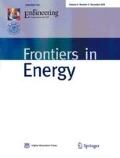Abstract
This paper investigated radiation heat transfer and temperature distributions of solar thermochemical reactor for syngas production using the finite volume discrete ordinate method (fvDOM) and P1 approximation for radiation heat transfer. Different parameters including absorptivity, emissivity, reflection based radiation scattering, and carrier gas flow inlet velocity that would greatly affect the reactor thermal performance were sufficiently investigated. The fvDOM approximation was used to obtain the radiation intensity distribution along the reactor. The drop in the temperature resulted from the radiation scattering was further investigated using the P1 approximation. The results indicated that the reactor temperature difference between the P1 approximation and the fvDOM radiation model was very close under different operating conditions. However, a big temperature difference which increased with an increase in the radiation emissivity due to the thermal non-equilibrium was observed in the radiation inlet region. It was found that the incident radiation flux distribution had a strong impact on the temperature distribution throughout the reactor. This paper revealed that the temperature drop caused by the boundary radiation heat loss should not be neglected for the thermal performance analysis of solar thermochemical reactor.
Similar content being viewed by others
References
Shuai Y, Wang F Q, Xia X L, Tan H P, Liang Y C. Radiative properties of a solar cavity receiver/reactor with quartz window. International Journal of Hydrogen Energy, 2011, 36(19): 12148–12158
Suter S, Steinfeld A, Haussener S. Pore-level engineering of macroporous media for increased performance of solar-driven thermochemical fuel processing. International Journal of Heat and Mass Transfer, 2014, 78: 688–698
Palumbo R, Keunecke M, Möller S, Steinfeld A. Reflections on the design of solar thermal chemical reactors: thoughts in transformation. Energy, 2004, 29(5–6): 727–744
Rupesh S, Muraleedharan C, Arun P. Energy and exergy analysis of syngas production from different biomasses through air-steam gasification. Frontiers in Energy, 2016, [Epub ahead of print] https:// doi.org/10.1007/s11708-016-0439-1
Ni W, Chen Z. Synergistic utilization of coal and other energy—key to low carbon economy. Frontiers in Energy, 2011, 5(1): 1–19
Müller R, Haeberling P, Palumbo R D. Further advances toward the development of a direct heating solar thermal chemical reactor for the thermal dissociation of ZnO(s). Solar Energy, 2006, 80(5): 500–511
Bellan S, Alonso E, Gomez-Garcia F, Perez-Rabago C, Gonzalez-Aguilar J, Romero M. Thermal performance of lab-scale solar reactor designed for kinetics analysis at high radiation fluxes. Chemical Engineering Science, 2013, 101: 81–89
Levêqque G, Abanades S. Investigation of thermal and carbothermal reduction of volatile oxides (ZnO, SnO2, GeO2, and MgO) via solardriven vacuum thermogravimetry for thermochemical production of solar fuels. Thermochimica Acta, 2015, 605: 86–94
Alonso E, Romero M. A directly irradiated solar reactor for kinetic analysis of non-volatile metal oxides reductions. International Journal of Energy Research, 2015, 39(9): 1217–1228
Ackermann S, Takacs M, Scheffe J, Steinfeld A. Reticulated porous ceria undergoing thermochemical reduction with high-flux irradiation. International Journal of Heat and Mass Transfer, 2017, 107: 439–449
Bachirou G L, Shuai Y, Zhang J, Huang X, Yuan Y, Tan H P. Syngas production by simultaneous splitting of H2O and CO2 via iron oxide (Fe3O4) redox reactions under high-pressure. International Journal of Hydrogen Energy, 2016, 41(44): 19936–19946
Kodama T, Gokon N. Thermochemical cycles for high-temperature solar hydrogen production. Chemical Reviews, 2007, 107(10): 4048–4077
Steinfeld A, Schubnell M. Optimum aperture size and operating temperature of a solar cavity-receiver. Solar Energy, 1993, 50(1): 19–25
Costandy J, El Ghazal N, Mohamed M T, Menon A, Shilapuram V, Ozalp N. Effect of reactor geometry on the temperature distribution of hydrogen producing solar reactors. International Journal of Hydrogen Energy, 2012, 37(21): 16581–16590
Kodama T. High-temperature solar chemistry for converting solar heat to chemical fuels. Progress in Energy and Combustion Science, 2003, 29(6): 567–597
Guene Lougou B, Hong J, Shuai Y, Huang X, Yuan Y, Tan H P. Production mechanism analysis of H2 and CO via solar thermochemical cycles based on iron oxide (Fe3O4) at high temperature. Solar Energy, 2017, 148: 117–127
Loutzenhiser P G, Galvez M E, Hischier L, Stamatiou A, Frei A, Steinfeld A. CO2 splitting via two-step solar thermochemical cycles with Zn/ZnO and FeO/Fe3O4 redox reactions II: kinetic analysis. Energy & Fuels, 2009, 23(5): 2832–2839
Gokon N, Mataga T, Kondo N, Kodama T. Thermochemical twostep water splitting by internally circulating fluidized bed of NiFe2O4 particles: successive reaction of thermal-reduction and water-decomposition steps. International Journal of Hydrogen Energy, 2011, 36(8): 4757–4767
Romero M, Steinfeld A. Concentrating solar thermal power and thermochemical fuels. Energy & Environmental Science, 2012, 5 (11): 9234–9245
Alonso E, Pérez-Rábago C, González-Aguilar J, Romero M. A novel lab-scale solar reactor for kinetic analysis of nonvolatile metal oxides thermal reductions. Energy Procedia, 2014, 57: 561–569
Abanades S, Charvin P, Flamant G. Design and simulation of a solar chemical reactor for the thermal reduction of metal oxides: case study of zinc oxide dissociation. Chemical Engineering Science, 2007, 62(22): 6323–6333
Schunk L O, Haeberling P, Wepf S, Wuillemin D, Meier A, Steinfeld A. A receiver-reactor for the solar thermal dissociation of zinc oxide. Journal of Solar Energy Engineering, Transactions of the ASME, 2008, 130(2): 0210091–0210096
Wang M, Siddiqui K. The impact of geometrical parameters on the thermal performance of a solar receiver of dish-type concentrated solar energy system. Renewable Energy, 2010, 35(11): 2501–2513
Chabane F, Hatraf N, Moummi N. Experimental study of heat transfer coefficient with rectangular baffle fin of solar air heater. Frontiers in Energy, 2014, 8(2): 160–172
Steinfeld A, Schubnell M. Optimum aperture size and operating temperature of a solar cavity-receiver. Solar Energy, 1993, 50(1): 19–25
Shuai Y, Xia X L, Tan H P. Radiation performance of dish solar concentrator cavity/receiver systems. Solar Energy, 2008, 82(1): 13–21
Cheng Z D, He Y L, Xiao J, Tao Y B, Xu R J. Three-dimensional numerical study of heat transfer characteristics in the receiver tube of parabolic trough solar collector. International Communications in Heat and Mass Transfer, 2010, 37(7): 782–787
Mao Q, Shuai Y, Yuan Y. Study on radiation flux of the receiver with a parabolic solar concentrator system. Energy Conversion and Management, 2014, 84: 1–6
Villafán-Vidales H I, Abanades S, Caliot C, Romero-Paredes H. Heat transfer simulation in a thermochemical solar reactor based on a volumetric porous receiver. Applied Thermal Engineering, 2011, 31(16): 3377–3386
Wu Z Y, Caliot C, Flamant G, Wang Z. Coupled radiation and flow modeling in ceramic foam volumetric solar air receivers. Solar Energy, 2011, 85(9): 2374–2385
Yin J Y, Liu L H. Analysis of the radiation heat transfer process of phase change for a liquid droplet radiator in space power systems. Frontiers in Energy, 2011, 5(2): 166–173
Guene Lougou B, Shuai Y, Xing H, Yuan Y, Tan H P. Thermal performance analysis of solar thermochemical reactor for syngas production. International Journal of Heat and Mass Transfer, 2017, 111: 410–418
Wang F Q, Shuai Y, Tan H P, Yu C L. Thermal performance analysis of porous media receiver with concentrated solar irradiation. International Journal of Heat and Mass Transfer, 2013, 62(1): 247–254
Wang F Q, Shuai Y, Tan H P, Zhang X F, Mao Q J. Heat transfer analyses of porous media receiver with multi-dish collector by coupling MCRT and FVM method. Solar Energy, 2013, 93: 158–168
Wang F Q, Tan J Y, Yong S, Tan H P, Chu S X. Thermal performance analyses of porous media solar receiver with different irradiative transfer models. International Journal of Heat and Mass Transfer, 2014, 78: 7–16
Trépanier J-Y, Melot M, Camarero R, Petro E. Comparison of two models for radiative heat transfer in high-temperature thermal plasmas. Modelling and Simulation in Engineering, 2011, 285108
Kräupl S, Steinfeld A. Experimental investigation of a vortex-flow solar chemical reactor for the combined ZnO-reduction and CH4-reforming. Journal of Solar Energy Engineering, Transactions of the ASME, 2001, 123(3): 237–243
Modest M F. Radiative Heat Transfer. 3rd edition. San Diego: Academic Press, 2013
Modest M F. Radiative Heat Transfer. Burlington: Academic Press, 2003
Sazhin S S, Sazhina E M, Faltsi-Saravelou O, Wild P. The P-1 model for thermal radiation transfer: advantages and limitations. Fuel, 1996, 75(3): 289–294
Abanades S, Flamant G. Experimental study and modeling of a high temperature solar chemical reactor for hydrogen production from methane cracking. International Journal of Hydrogen Energy, 2007, 32(10–11): 1508–1515
Abanades S, Flamant G. Production of hydrogen by thermal methane splitting in a nozzle-type laboratory scale solar reactor. International Journal of Hydrogen Energy, 2005, 30(8): 843–853
Acknowledgments
This work was supported by the National Natural Science Foundation of China (Grant Nos. 51522601 and 51421063) and the program for New Century Excellent Talents in University (Grant No. NCET-13-0173).
Author information
Authors and Affiliations
Corresponding authors
Rights and permissions
About this article
Cite this article
Guene Lougou, B., Shuai, Y., Chen, X. et al. Analysis of radiation heat transfer and temperature distributions of solar thermochemical reactor for syngas production. Front. Energy 11, 480–492 (2017). https://doi.org/10.1007/s11708-017-0506-2
Received:
Accepted:
Published:
Issue Date:
DOI: https://doi.org/10.1007/s11708-017-0506-2




